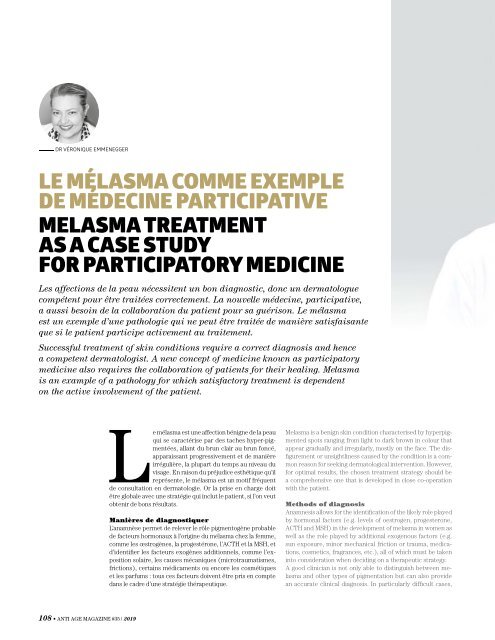ANTI-AGE #35
Create successful ePaper yourself
Turn your PDF publications into a flip-book with our unique Google optimized e-Paper software.
DR VÉRONIQUE EMMENEGGER<br />
LE MÉLASMA COMME EXEMPLE<br />
DE MÉDECINE PARTICIPATIVE<br />
MELASMA TREATMENT<br />
AS A CASE STUDY<br />
FOR PARTICIPATORY MEDICINE<br />
Les affections de la peau nécessitent un bon diagnostic, donc un dermatologue<br />
compétent pour être traitées correctement. La nouvelle médecine, participative,<br />
a aussi besoin de la collaboration du patient pour sa guérison. Le mélasma<br />
est un exemple d’une pathologie qui ne peut être traitée de manière satisfaisante<br />
que si le patient participe activement au traitement.<br />
Successful treatment of skin conditions require a correct diagnosis and hence<br />
a competent dermatologist. A new concept of medicine known as participatory<br />
medicine also requires the collaboration of patients for their healing. Melasma<br />
is an example of a pathology for which satisfactory treatment is dependent<br />
on the active involvement of the patient.<br />
Le mélasma est une affection bénigne de la peau<br />
qui se caractérise par des taches hyper-pigmentées,<br />
allant du brun clair au brun foncé,<br />
apparaissant progressivement et de manière<br />
irrégulière, la plupart du temps au niveau du<br />
visage. En raison du préjudice esthétique qu’il<br />
représente, le mélasma est un motif fréquent<br />
de consultation en dermatologie. Or la prise en charge doit<br />
être globale avec une stratégie qui inclut le patient, si l’on veut<br />
obtenir de bons résultats.<br />
Manières de diagnostiquer<br />
L’anamnèse permet de relever le rôle pigmentogène probable<br />
de facteurs hormonaux à l’origine du mélasma chez la femme,<br />
comme les œstrogènes, la progestérone, l’ACTH et la MSH, et<br />
d’identifier les facteurs exogènes additionnels, comme l’exposition<br />
solaire, les causes mécaniques (microtraumatismes,<br />
frictions), certains médicaments ou encore les cosmétiques<br />
et les parfums : tous ces facteurs doivent être pris en compte<br />
dans le cadre d’une stratégie thérapeutique.<br />
Melasma is a benign skin condition characterised by hyperpigmented<br />
spots ranging from light to dark brown in colour that<br />
appear gradually and irregularly, mostly on the face. The disfigurement<br />
or unsightliness caused by the condition is a common<br />
reason for seeking dermatological intervention. However,<br />
for optimal results, the chosen treatment strategy should be<br />
a comprehensive one that is developed in close co-operation<br />
with the patient.<br />
Methods of diagnosis<br />
Anamnesis allows for the identification of the likely role played<br />
by hormonal factors (e.g. levels of oestrogen, progesterone,<br />
ACTH and MSH) in the development of melasma in women as<br />
well as the role played by additional exogenous factors (e.g.<br />
sun exposure, minor mechanical friction or trauma, medications,<br />
cosmetics, fragrances, etc.), all of which must be taken<br />
into consideration when deciding on a therapeutic strategy.<br />
A good clinician is not only able to distinguish between melasma<br />
and other types of pigmentation but can also provide<br />
an accurate clinical diagnosis. In particularly difficult cases,<br />
108 • <strong>ANTI</strong> <strong>AGE</strong> MAGAZINE <strong>#35</strong> | 2019

















